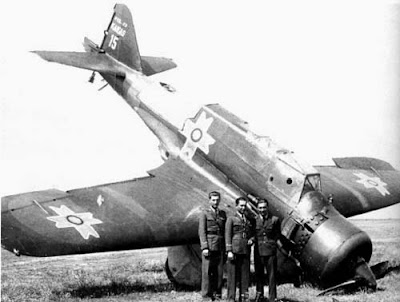The PZL.23 Karaś was a Polish light bomber and reconnaissance aircraft designed in the mid-1930s by PZL in Warsaw. It was the primary Polish reconnaissance bomber in use during the Invasion of Poland.
-------------------------
The aircraft was a low-wing cantilever monoplane of all-metal, metal-covered construction. The crew of three consisted of a pilot, a bombardier, and a rear gunner. The bombardier's combat station was situated in a gondola underneath the hull, where he could also operate an underbelly machine gun. The fixed undercarriage was well spatted, but despite a massive look, it was not suited for rough airfields.
Bombs were carried under the wings: the maximum load was 700 kg (1,500 lb) (6 x 100 kg and 2 x 50 kg). The aircraft were equipped with one of the following engines: Bristol Pegasus IIM2 normal: 570 hp (425 kW), maximum: 670 hp (500 kW) - PZL.23A; Pegasus VIII normal: 650 hp (485 kW), maximum: 720 (537 kW) - PZL.23B. Regardless of the engine, the aircraft had a two-blade propeller.
The Bristol engines were licensed for use in Poland only, so for export purposes the Gnome-Rhône 14K was used in a variety of PZL designs. In this case the 14K-powered PZL.23, with some changes to the airframe, became the PZL.43 Karaś. Final export variant was PZL.43A, with 1,020 hp Gnome-Rhone 14N-01 engine. 52 PZL.43s were made in total, all for Bulgaria only. The new engine improved the aircraft's performance considerably, maximum speed increased to 365 km/h.
-----------------------------
Forty PZL.23As were delivered to the Polish Air Force in late 1936. Due to engine faults, their service ceiling was limited and they were used only in the training role, being fitted with dual controls. A total of 210 PZL.23Bs were delivered to the Air Force from 1937. They became the main armament of Polish bomber and reconnaissance "line squadrons", in the 1930s replacing Breguet 19, Potez 25 and Potez 27 biplanes. By August 1939, there had been 23 reported crashes, an average safety result.
By 1939, the aircraft was obsolescent. The main deficiency was its low speed but a lack of maneuverability also proved a problem (the maximum speed of the PZL.23B was 365 km/h, but it was forbidden to exceed 319 km/h due to dangerous flight characteristics). However, at the outbreak of World War II on 1 September 1939, during the invasion of Poland, it remained Poland's primary light bomber and reconnaissance aircraft.
Some PZL.23s were also used in wartime improvised units with 114 PZL.23Bs deployed in combat units (a further 75 PZL.23B and 35 PZL.23A were in air schools, held in reserve or under repair). The PZL.23Bs were operational in five bomber squadrons (Eskadra Bombowa) of the Bomber Brigade and seven Army reconnaissance squadrons, each with 10 aircraft (other squadrons of the Bomber Brigade were equipped with PZL.37 Łoś). In addition two PZL.43A from the Bulgarian order were impressed into the Polish service in the 41st Squadron.
On 2 September 1939, one PZL.23B of the 21st Squadron bombed a factory in Ohlau, the first bomb attack on the German Third Reich. The PZL.23 bomber squadrons also attacked German armoured columns, especially on 3 September 1939, while the main mission of the Army squadrons was reconnaissance. The five squadrons of the Bomber Brigade delivered about 52-60 tons of bombs during the campaign, the Army squadrons added about another dozen tons.
Due to the plane's low speed, light armour and (most importantly) lack of fighter protection, PZL.23s suffered heavy combat losses. Many were shot down by German fighter aircraft, but they also shot down several in return. Despite the lack of armour, crews often attacked German columns from low level, making their aircraft vulnerable to AA fire. Some 20 aircraft were lost in crash landings on the improvised and rough airfields.
About 120 PZL.23s (86%) were destroyed in 1939, but only 67 due to direct enemy action. And only a small number were destroyed on airfields, with the only large scale Luftwaffe success of this type occurring on 14 September, at Hutniki airfield, against PZL.23Bs of the Bomber Brigade.
At least 21 PZL.23s were evacuated in 1939 to Romania with 19 used by the Romanian Air Force against the USSR. 50 PZL.43s and PZL.43As (two were delivered by the Germans) were used in Bulgaria for training until 1946, known as the "Chaika". No PZL.23s survived the war.







Ei kommentteja:
Lähetä kommentti
Kaikenlaiset kommentit ovat tervetulleita.